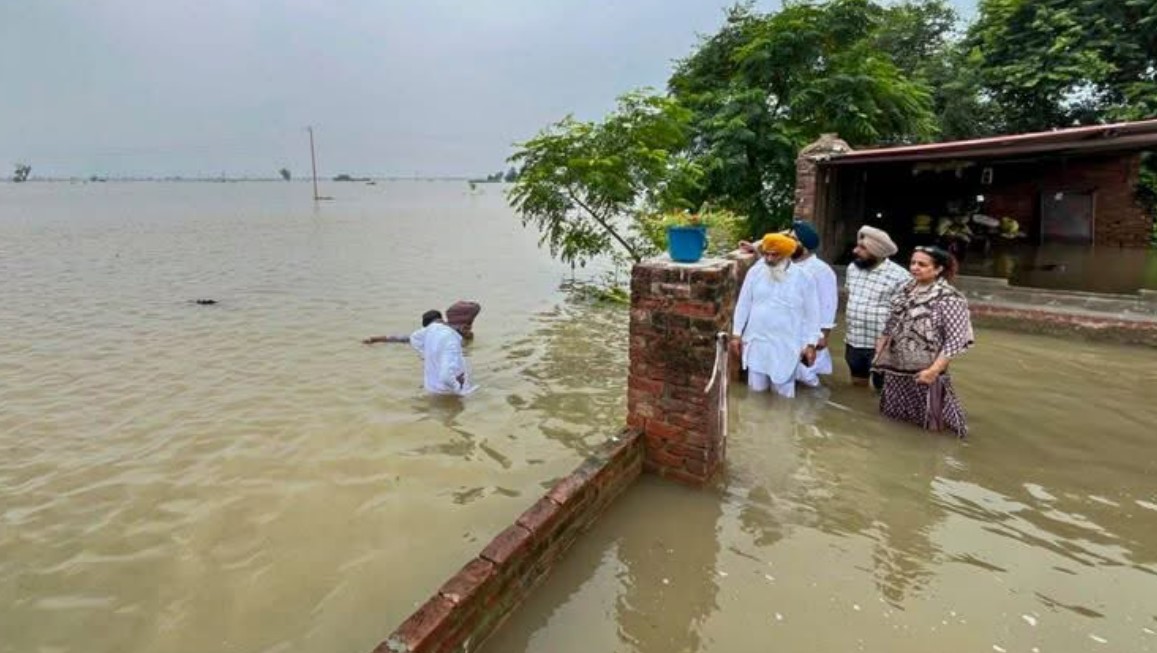Punjab is reeling from its most catastrophic floods in decades, with over 4 lakh acres of farmland submerged, livelihoods devastated, and the fabric of rural life deeply scarred. The crisis has reignited debate over the underlying causes of repeated flooding: from climate and riverine geography to governance failures and deep-seated resistance to critical water management infrastructure by sections of the state’s own people.
The current flood crisis
This August and September, record rainfall and swollen rivers, particularly the Sutlej, Beas, and Ravi, have inundated all 23 districts of Punjab. More than 1,900 villages have been impacted, with close to 4,00,000 people affected and at least 43 lives lost. Over 4 lakh acres of standing crops, predominantly paddy due for harvest, have been ruined, compounding distress for families whose livelihoods depend almost solely on farming. Livestock losses, damage to rural infrastructure, and mass displacements have triggered a humanitarian crisis, with rescue and relief operations ongoing at unprecedented scale.
Impact on livelihoods and crops
Punjab, India’s ‘food bowl’, produces over 12% of the nation’s rice and supplies up to 40% of basmati exports. This year, the floods struck just before harvest, wiping out an estimated 20–25% of the basmati crop along with large tracts of other paddy fields and cash crops in districts like Amritsar, Gurdaspur, Kapurthala, Fazilka, and Barnala. Small farmers, agricultural labourers, and local communities now face food insecurity, rising debt, lost earnings, and future uncertainty as input shortages and ruined fields threaten the upcoming rabi crop as well.
Why Punjab keeps flooding
Geography and climate
Punjab’s river system, once sustaining, now menacing, is naturally prone to flooding due to its extensive network of perennial rivers, tributaries, and seasonal watercourses. Erratic, intense monsoon rains have become more frequent and unpredictable due to climate change, pushing the rivers to and beyond their capacity.
Reluctance over canals and release of water
A notable factor is the resistance of state residents to canal construction or desilting projects, spurred by fears that new canals would reduce cultivable land or benefit neighbouring states more than Punjab. There is also well-documented opposition to permitting surplus river water to flow downstream into Haryana and Rajasthan, with local groups demanding every possible drop be retained, sometimes against expert advice.
Governance and water management failures
Years of weak governance and poor decision-making have compounded flooding. Drains and canal systems are often choked with debris, embankments are poorly maintained or illegally breached, and short-term politics has trumped long-term planning.
Financial and political constraints have led to crumbling flood defences and underfunded infrastructure projects. Governance is further complicated by inter-state disputes: Punjab, Haryana, and Rajasthan routinely deadlock over water-sharing, paralysing regional solutions.
Encroachments and land use
Encroachment on floodplains, widespread concretisation, and illegal construction have narrowed natural water flow pathways. Deforestation, illegal sand mining, and the conversion of wetlands to fields has destroyed natural “sponges” that once absorbed excess water, amplifying deluge risks in heavy rainfall years.
Dams, releases, and transboundary water tensions
The management of major dams, Bhakhra, Pong, and Ranjit Sagar, remains a flashpoint. Controlled, but sometimes delayed, releases during heavy rainfall to prevent dam failure have often worsened flooding downstream. Disputes persist with neighbouring states (especially Haryana) over water release timings and sharing, further worsening the crisis.
The tragedy overwhelming Punjab today is as much an outcome of geography and climate as of collective denial and mismanagement. The state’s refusal to build or modernise canals, chokehold on river water within borders, encroachment on floodplains, and governance shortfalls have deepened vulnerability and turned periodic flooding into widespread disaster. Unless Punjab, its people, and political leaders embrace science-driven water management and regional cooperation, the land of five rivers will continue to drown in the very waters that once made it fertile.
